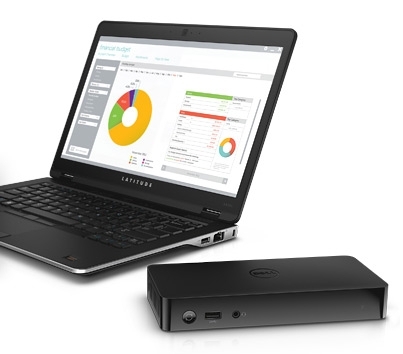 “Tri-band” encompasses the two bands used by 802.11n Wi-Fi: 2.4GHz and 5 GHz, as well as the new 802.11ad WiGig band at 60 GHz. The 2.4 and 5 GHz connections allow the Latitude 6430u to connect to your business’ already-installed Wi-Fi network with ease, and the 60 GHz connection introduces something new: very high bandwidth wireless data transfer.
“Tri-band” encompasses the two bands used by 802.11n Wi-Fi: 2.4GHz and 5 GHz, as well as the new 802.11ad WiGig band at 60 GHz. The 2.4 and 5 GHz connections allow the Latitude 6430u to connect to your business’ already-installed Wi-Fi network with ease, and the 60 GHz connection introduces something new: very high bandwidth wireless data transfer.
While this new standard will soon roll out to the rest of the industry, Dell is first to market. Latitude 6430u can now display video, connect to the network and wirelessly connect all your existing peripherals via its new wireless dock with no lag, interference or stuttering. When arriving at your desk, rather than plugging in all these devices, your Ultrabook and wireless dock (see Brett's recent blog post for more) will discover each other and automatically connect. The high-bandwidth, short-range capacity of 60 GHz allows unprecedented connectivity.
60 GHz 802.11ad is designed to handle high-bandwidth, low-latency traffic. Tri-band wireless docking allows all peripheral traffic – every key press, mouse click, second of audio and frame of video – to travel simultaneously across its interface. More network traffic isn’t likely to be a problem, since regular Internet traffic and WiGig docking is handled across separate systems on the Tri-band module.
WiGig is a robust protocol established and driven by the Wireless Gigabit Alliance, comprising dozens of industry-leading member companies including Dell, Qualcomm and Wilocity. This gives WiGig an advantage for the business computing customer: it’s a specification with broad-based support, has multiple partners invested in its success, and will exist as a standard for years to come, future-proofing hardware decisions made today.
———–
Vivek Gupta is the vice president and general manager for Qualcomm Atheros computing solutions division. Prior to Qualcomm’s acquisition of Atheros Communications, Vivek held positions at Atheros ranging from vice president and general manager for the company’s computing division to contributing to business development within Atheros’ mobile business unit.